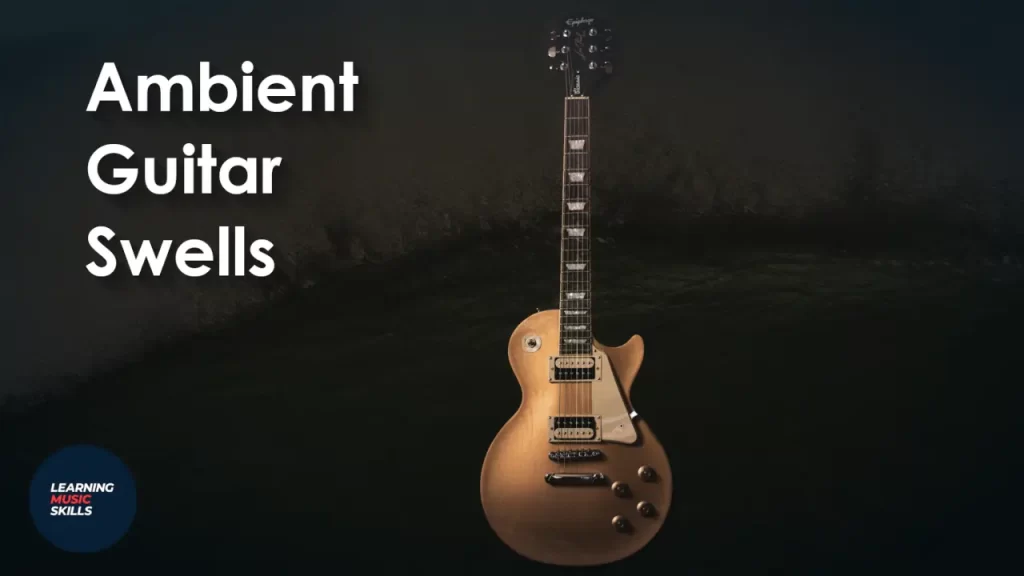Creating ambient guitar swells is one of my favourite ambient guitar techniques. They sound so rich and spacious. And the best thing is that you can use them in practically any song or

The free tutorials and articles from Learning
If you want to learn how to create your own ambient guitar swells, then I recommend you check out my article on YouTube tutorial on how to make beautiful ambient guitar swells inside your DAW with only plugins. In this tutorial, I also touch ground on what effects you can best use for ambient
Download 192 Beautiful Ambient Guitar Swells for Your Music
What Are Ambient Guitar Swells?
Guitar swells, also known as volume swells or volume pedal swells, are a playing technique used on the guitar to create a smooth and gradual increase in volume. This creates an amazing rising or swelling sound. What you basically do is remove your initial attack of the notes. This technique is commonly associated with ambient
Here’s how guitar swells work when played live:
- Volume Control or Pedal: You can create guitar swells using your guitar’s volume knob, a volume pedal.
- Picking or Strumming: To begin a swell, you pick or strum the strings while keeping the volume knob or pedal at a low setting, this makes the sound muted or very soft.
- Gradual Increase: While the strings are still ringing, you smoothly increase the volume using the volume knob or pedal.
- Control and Expression: The key to great ambient guitar swells is to maintain a steady and controlled increase in volume. You want to create a seamless, swelling effect that gradually fills the space with an enormous sound.
- Effect and Ambience: Guitar swells are often used in ambient or atmospheric
music to create a sense of space, and emotion. This gradual increase in volume can evoke feelings of tranquillity, mystery, or tension. - Use of Effects: Ambient guitar swells sound the best with effects like reverb and delay. These effects add a sense of depth and sustain to the swelled notes and chords. Ambient
music would not exist without these effects if you ask me.
Guitar volume swells can be very expressive and are used to add texture, emotion, and a special ambient layer to the
Why is ambient music so beautiful?
A question that I have often asked myself is what makes ambient
- Feelings and Mood: Ambient
music can help you feel calm, thoughtful, and connected to your emotions. This feeling of beauty comes from themusic ‘s ability to create a deep and special atmosphere. - Emotional Connection: Unlike other styles of
music that have traditional melodies and beats, ambientmusic focuses on different sounds that can make you feel things. There are no strong melodies or beats and pulses. This allows you to make your own personal connection with themusic . - Open and Free Feeling: Ambient
music often sounds open and wide, like you’re in a big space. This is because of the reverb and delays that are often found in ambientmusic . This makes it easy for your mind to explore and think. - Hidden Complexity: Even though it might sound simple at first, some ambient
music has a lot of layers of hidden sounds inside. When you listen closely, you can discover these hidden parts, which makes themusic more interesting and beautiful. - Relaxing and Stress Relief: Ambient
music can take away stress and help you relax. When you’re more relaxed. In general, when you are relaxed, you feel good. - Using Your Imagination: Ambient
music doesn’t always follow the usual rules ofmusic . You can use your imagination to make themusic mean something personal to you. - Daydreaming: Ambient
music can take your thoughts to different places in your mind. - Everyone Feels Differently: Because ambient
music does not tell you how to feel there is no strict beauty attached to it. What’s beautiful to one person might not be the same for another.
Ambient
Recommended Music Tutorial: The Key Elements for a Sad Song and Melancholic Music
Your Support Matters
Support new videos by becoming a member and receive benefits in return. Or by giving a one-time donation! Help me provide free
https://www.buymeacoffee.com/musicskills
What are the key elements of ambient music ?
If you want to start writing ambient
- Sounds and How They Feel: In ambient
music , the way sounds feel is more important than melodies or beats. - Slow and Relaxed: Ambient
music is often very slow and calm. The slow speed makes themusic peaceful and good for thinking and relaxing. - Repeating and Simple: Ambient
music often has repeating patterns that sound simple but beautiful. - Long Sounds: In general, the
music uses long sounds that last a long time. The effect is that it makes you feel like you’re in a big space. - Layers and Changes: Ambient
music has many layers of sound that change slowly over time. This gives depth and interest to themusic . - No Regular Structure: It doesn’t follow the usual song structure with verses and choruses. It flows without clear patterns.
- Sounds from the World: Depending on the style and sub-genre, ambient
music sometimes has sounds from nature or cities. - Simple Harmony: There are no elaborate chord progressions in ambient
music . - Real Sounds: Some ambient
music has recordings of sounds, like water or wind. Of course, this depends on the style because this can very easily become kitsch. - Special Effects: Ambient
music uses special effects to make instruments sound huge. The effects that are most often used are reverb and delay. - Feelings and Atmosphere: Ambient
music aims to create a special feeling or mood.
All these things together make ambient



